Bullock’s heart
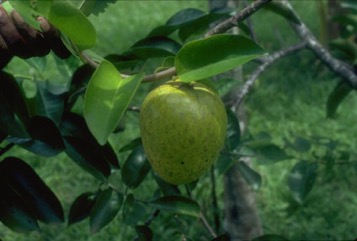
A tropical plant. It occurs in the tropical lowlands and grows up to at least 1200 m altitude. In Colombia it grows between 500-1,900 m above sea level. It can grow on poorer soils with different levels of acidity. It cannot stand water-logging. It suits humid climates. It is less suited to dry climates. It can grow in arid places. In Nepal it grows to 900 m altitude. It suits hardiness zones 10-12. In Yunnan. In Brisbane Botanical Gardens.
Also known as:
Aanti, Aata, Anona colorado, Anonas, Ata, Atha, Attha, Balam, Chotka salifa, Condessa, Coracao-de-boi, Corazon, Corossol, Fat manao, Fat manaova, Kasjoema, Keradebefo, Kisitaffeeli, Krishna-beejam, Lavani, Madargamja, Mamon, Neoa, Netted custard apple, Noi-nah, Nona ata, Nona kapri, Ramasita, Ramphal, Ramsitha, Sacha anona, Sita phal, Thinbaw-awza, Uto ni bulamakau, Voankobohobo, Weli-attha
Synonyms
- Annona excelsa Kunth.
- Annona humbodtiana Kunth.
- Annona humboldtii Dun.
- Annona laevis Kunth
- Annona longifolia Sesse & Moc.
- Annona lutescens Saff. Annona riparia Kunth.
Edible Portion
- Fruit
Where does Bullock’s heart grow?
Found in: Africa, Amazon, Andamans, Angola, Antilles, Asia, Australia, Bahamas, Bangladesh, Belize, Bolivia, Brazil, Cambodia, Cameroon, Central Africa, Central America, China, Colombia, Cook Islands, Costa Rica, Cuba, Dominican Republic, East Africa, East Timor, Ecuador, Fiji, Gabon, Grenada, Guam, Guatemala, Guyana, Haiti, Hawaii, Himalayas, Honduras, India, Indochina, Indonesia, Jamaica, Kenya, Laos, Madagascar, Malawi, Malaysia, Maldives, Mariana Islands, Marquesas, Marshall Is., Martinique, Mexico, Mozambique, Myanmar, Nauru, Nepal, North America, Northeastern India, Pacific, Pakistan, Palau, Panama, Papua New Guinea, PNG, Peru, Philippines, Puerto Rico, Rotuma, Sao Tome and Principe, SE Asia, Solomon Islands, South America, Sri Lanka, St. Vincent and Grenadines, Suriname, Taiwan, Tanzania, Timor-Leste, Thailand, Tonga, Uganda, United States, Vanuatu, Venezuela, Vietnam, West Africa, West Indies, West Timor, Zambia, Zimbabwe
Notes: There are about 100-150 Annona species. It has anticancer properties.
Status: It is a cultivated fruit tree. Commonly seen on Manus Island and in some other coastal areas in Papua New Guinea.
Growing Bullock’s heart
Cultivation: Plants are normally grown from seeds. Seedling trees vary quite a bit. Seedlings are easy to transplant. A spacing of 4-7 m is suitable. Better kinds can be grown using budding or grafting.
Edible Uses: The ripe fruit is eaten fresh. They are also used for preserves, drinks, ice cream, custards and other desserts CAUTION: The seed kernel is poisonous.
Production: Trees begin fruiting at 3-5 years. Fruit setting is often improved by hand pollination. Fruit mature in about 200 days. Fruit can vary from 0.25 to 2.25 kg each. The fruit has 13% sugar. Fruit production is seasonal. A tree may bear 100-150 fruit in a season. The season is normally Dec. to March.
Nutrition Info
per 100g edible portion| Edible Part | Energy (kcal) | Protein (g) | Iron (mg) | Vitamin A (ug) | Vitamin c (mg) | Zinc (mg) | % Water |
|---|---|---|---|---|---|---|---|
| Fruit | 111 | 2.06 | 0.5 | 10 | 50 | - | 66.4 |
Bullock’s heart Photos

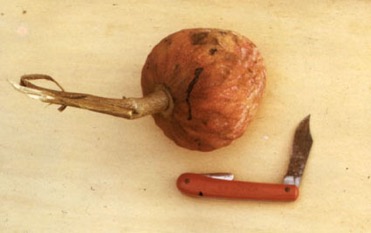
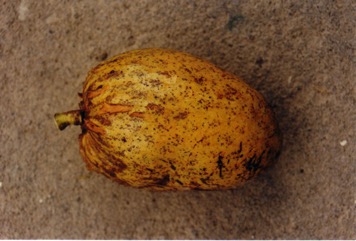
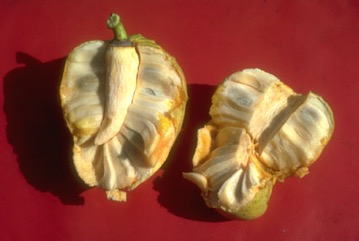
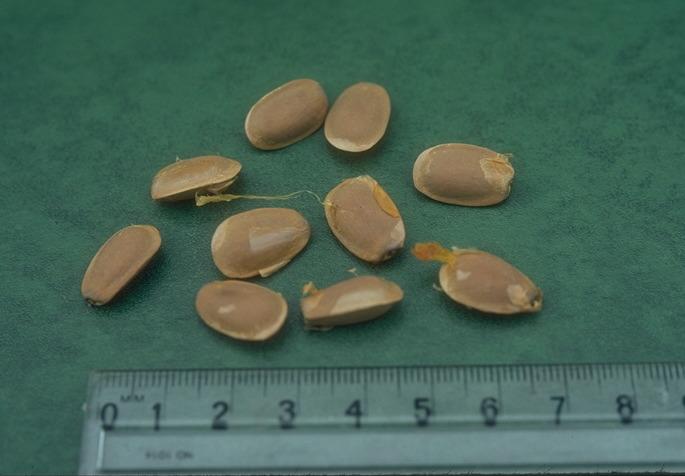
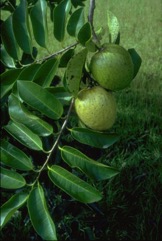
References
Bullock’s heart references
Ajesh, T. P., et al, 2012, Ethnobotanical Documentation of Wild Edible Fruits used by Muthuvan Tribes of Idukki, Kerala-India. International Journal of Pharma and Bio Sciences 3(3): 479-487
Ambasta S.P. (Ed.), 2000, The Useful Plants of India. CSIR India. p 43
Anderson, E. F., 1993, Plants and people of the Golden Triangle. Dioscorides Press. p 202
Ashton, M. S., et al 1997, A Field Guide to the Common Trees and Shrubs of Sri Lanka. WHT Publications Ltd. p 100
Bajpai, O., et al, 2015, Tree species of the Himalayan Terai region of Uttar Pradesh, India: a checklist. Check List 11(4): 1718
Bandyopadhyay, S. et al, 2009, Wild edible plants of Koch Bihar district, West Bengal. Natural Products Radiance 8(1) 64-72
Bandyopadhyay, S., et al, 2012, A Census of Wild Edible Plants from Howrah District, West Bengal, India. Proceedings of UGC sponsored National Seminar 2012
Banerjee, A., et al, 2013, Ethnobotanical Documentation of Some Wild Edible Plants in Bankura District, West Bengal, India. The Journal of Ethnobiology and Traditional Medicine. Photon 120 (2013) 585-590
Barwick, M., 2004, Tropical and Subtropical Trees. A Worldwide Encyclopedic Guide. Thames and Hudson p 27
Bircher, A. G. & Bircher, W. H., 2000, Encyclopedia of Fruit Trees and Edible Flowering Plants in Egypt and the Subtropics. AUC Press. p 31
Bodkin, F., 1991, Encyclopedia Botanica. Cornstalk publishing, p 86
Bourret, D., 1981, Bonnes-Plantes de Nouvelle-Caledonie et des Loyaute. ORSTOM. p 38
Brahma, S., et al, 2013, Wild edible fruits of Kokrajhar district of Assam, North-East India, Asian Journal of Plant Science and Research 3(6):95-100
Brouk, B., 1975, Plants Consumed by Man. Academic Press, London. p 170
Brown, 1951, Useful Plants of the Philippines.
Burkill, H. M., 1985, The useful plants of west tropical Africa, Vol. 1. Kew.
Burkill, I. H., 1935, A Dictionary of the Economic Products of the Malay Peninsula. p 168
Casas, A., et al, 1996, Plant Management Among the Nahua and the Mixtec in the Balsas River Basin, Mexico: An Ethnobotanical Approach to the Study of Plant Domestication. Human Ecology, Vol. 24, No. 4 pp. 455-478
Chakraborty, S. & Chaturbedi, H. P., 2014, Some Wild Edible Fruits of Tripura- A Survey. Indian Journal of Applied research. (4) 9
Chandrashekara, U. M., 2009, Tree species yielding edible fruit in the coffee-based homegardens of Kerala, India: their diversity, uses and management. Food Sec. 1:361-370
Chin, H.F., & Yong, H.S., 1996, Malaysian Fruits in Colour. Tropical press, Kuala Lumpur p 57
Chizmar Fernandez, C., et al, 2009, Plantas comestibles de Centroamerica. Instituto de Biodiversidad, Costa Rica. p 38
Chowdery, T., et al, 2014, Wild edible plants of Uttar Dinajpur District, West Bengal. Life Science Leaflets. 47:pp 20-36 http://lifesciencesleaflets.ning.com
Chowdhury, M. & Mukherjee, R., 2012, Wild Edible Plants Consumed by Local Communities of Maldah of West Bengal, India. Indian J.Sci.Res.3(2) : 163-170
Cooper, W. and Cooper, W., 2004, Fruits of the Australian Tropical Rainforest. Nokomis Editions, Victoria, Australia. p 19
Coronel, R.E., 1982, Fruit Collections in the Philippines. IBPGR Newsletter p 6
Darley, J.J., 1993, Know and Enjoy Tropical Fruit. P & S Publishers. p 2
Das, S. and De, B., 2013, Evaluation of Angiotension I-Converting Enzyme (ACE) inhibitory potential of some underutilized indigenous fruits of West Bengal using an in vitro model. Fruits, Vol. 68:499-506
Das, T. & Das, A. K., 2005, Inventorying plant biodiversity in homegardens: A case study in Barak Valley, Assam, North East India. CURRENT SCIENCE, VOL. 89, NO. 1, 10 JULY 2005
Datar, M. N. & Upadhye, A. S., 2015, Forest foods of Northern Western Ghats: Mode of Consumption, Nutrition, and Availability. Asian Agri-History Vol. 19, No. 4, 2015 (293–316)
Dobriyal, M. J. R. & Dobriyal, R., 2014, Non Wood Forest Produce an Option for Ethnic Food and Nutritional Security in India. Int. J. of Usuf. Mngt. 15(1):17-37
Etherington, K., & Imwold, D., (Eds), 2001, Botanica's Trees & Shrubs. The illustrated A-Z of over 8500 trees and shrubs. Random House, Australia. p 96
Facciola, S., 1998, Cornucopia 2: a Source Book of Edible Plants. Kampong Publications, p 12
Flowerdew, B., 2000, Complete Fruit Book. Kyle Cathie Ltd., London. p 157
French, B., 1986, Food Plants of Papua New Guinea, Asia Pacific Science Foundation p 213
French, B.R., 2010, Food Plants of Solomon Islands. A Compendium. Food Plants International Inc. p 212
Garner, R.J., and Chaudhri, S.A., (Ed.) 1976, The Propagation of Tropical fruit Trees. FAO/CAB. p 223. 239
Grandtner, M. M. & Chevrette, J., 2013, Dictionary of Trees, Volume 2: South America: Nomenclature, Taxonomy and Ecology. Academic Press p 39
Goode, P., 1989, Edible Plants of Uganda. FAO p 27
Ghosh, C. & Das A. P., 2011, Some useful and poisonous tea garden weeds from the Darjiling District of West Bengal, India. Pleione 5(1): 91 - 114
Hedrick, U.P., 1919, (Ed.), Sturtevant's edible plants of the world. p 58
Hermandez Bermejo, J.E., and Leon, J. (Eds.), 1994, Neglected Crops. 1492 from a different perspective. FAO Plant Production and Protection Series No 26. FAO, Rome. p14, 89
Hibbert, M., 2002, The Aussie Plant Finder 2002, Florilegium. p 29
Jadhav, R., et al, 2015, Forest Foods of Northern Western Ghats: Mode of Consumption, Nutrition and Availability. Asian Agri-History Vol. 19, No. 4: 293-317
Jardin, C., 1970, List of Foods Used In Africa, FAO Nutrition Information Document Series No 2.p 120
Johns, L. & Stevenson, V., 1979, The Complete Book of Fruit. Angus & Robertson. p 122
Kintzios, S. E., 2006, Terrestrial Plant-Derived Anticancer Agents and Plant Species Used in Anticancer research Critical Reviews in Plant Sciences. 25: pp 79-113
Kiple, K.F. & Ornelas, K.C., (eds), 2000, The Cambridge World History of Food. CUP p 1890
Kumar, S. A., Manus, D. & Mallika, M., 2018, Impact of non-timber forest products on Forest and in Livelihood Economy of the People of Adjoining Areas of Jalpaiguri Forest Division, West Bengal, India. Int. J. of Life Sciences, 2018; 6 (2):365-385
Lazarides, M. & Hince, B., 1993, Handbook of Economic Plants of Australia, CSIRO. p 21
Leon, J., 1968, Fundamentos Botanicos de los Cultivos tropicales. p
Lorenzi, H., Bacher, L., Lacerda, M. & Sartori, S., 2006, Brazilian Fruits & Cultivated Exotics. Sao Paulo, Instituto Plantarum de Estuados da Flora Ltda. p 360
Macmillan, H.F. (Revised Barlow, H.S., et al) 1991, Tropical Planting and Gardening. Sixth edition. Malayan Nature Society. Kuala Lumpur. p 291
Maisch, 1885, Amer. Journ. Pharm. 57 p339
Manandhar, N.P., 2002, Plants and People of Nepal. Timber Press. Portland, Oregon. p 91
Martin, F. W., et al, 1987, Perennial Edible Fruits of the Tropics. USDA Handbook 642 p 17 (Also as Annona lutescens)
McMakin, P.D., 2000, Flowering Plants of Thailand. A Field Guide. White Lotus. p 104
Miguel, E., et al, 1989, A checklist of the cultivated plants of Cuba. Kulturpflanze 37. 1989, 211-357 (Also as Annona lutescens)
Milsum, 1919, Bull. 29. Dep. Agric. F.M.S. p 52
Morton, J. F., 1987, Fruits of Warm Climates. Wipf & Stock Publishers p 80
Murillo-A, J., 2001, Annonaceae of Colombia. Biota Colombiana 2(1): 49-51
NYBG Herbarium "edible"
Ochse. J.J. 1927, Indische Vruchten
Ochse, J.J., 1930, Fruits and Fruit Culture in the Dutch East Indies. p
Ochse, J.J., Dijkman, M.J., Soule, M.J. & Wehlburg,C., 1961, Tropical and Subtropical Agriculture. p
Omawale, 1973, Guyana's edible plants. Guyana University, Georgetown p 15
Paczkowska, G. & Chapman, A.R., 2000, The Western Australian Flora. A Descriptive Catalogue. Western Australian Herbarium. p 145
Pasha, M. K. & Uddin, S. B., 2019, Minor Edible Fruits of Bangladesh. Bangladesh J. Plant Taxon. 26(2): 299–313
Peekel, P.G., 1984, (Translation E.E.Henty), Flora of the Bismarck Archipelago for Naturalists, Division of Botany, Lae, PNG. p 183
Perry, F., and Hay, R., 1982, Guide to Tropical and Subtropical Plants. Sun Books p 10
Peters, C. R., O'Brien, E. M., and Drummond, R.B., 1992, Edible Wild plants of Sub-saharan Africa. Kew. p 54
Pham-Hoang Ho, 1999, An Illustrated Flora of Vietnam. Nha Xuat Ban Tre. p 244
Phon, P., 2000, Plants used in Cambodia. © Pauline Dy Phon, Phnom Penh, Cambodia. p 39
Plants of Haiti Smithsonian Institute http://botany.si.edu
Poponoe, W., 1920, Manual of Tropical and Subtropical fruits. Macmillan. p 186-188
Rajapaksha, U., 1998, Traditional Food Plants in Sri Lanka. HARTI, Sri Lanka. p 59
Raponda-Walker, A & Sillans, R., 1961, Les Plantes Utiles du Gabon. Editions Paul Lechevalier, Paris. p 63
Rashid, H. E., 1977, Geography of Bangladesh. Westview. p 343
Ramachandran, V.S. and Nair, V.J., 1981, Ethnobotanical studies in Cannanore District, Kerala State (India). J Econ. Tax. Bot. Vol 2 pp 65-72
Reddy, B. M., 2012, Wild edible plants of Chandrapur district, Maharashtra, India. Indian Journal of Natural Products and Resources. 3(1) pp 110-117
Royal Botanic Gardens, Kew (1999). Survey of Economic Plants for Arid and Semi-Arid Lands (SEPASAL) database. Published on the Internet; http://www.rbgkew.org.uk/ceb/sepasal/internet [Accessed 28th March 2011]
Safford, W.E., 1905, Useful Plants of Guam. Contrib. US Nat. Herb., 9, 184.
Segura, S. et al, 2018, The edible fruit species in Mexico. Genet Resour Crop Evol (2018) 65:1767–1793
Selvam, V., 2007, Trees and shrubs of the Maldives. RAP Publication No. 2007/12
Sharma, B.B., 2005, Growing fruits and vegetables. Publications Division. Ministry of Information and broadcasting. India. p 4
Smith, A.C., 1981, Flora Vitiensis Nova, Lawaii, Kuai, Hawaii, Volume 2 p 40
Solomon, C., 2001, Encyclopedia of Asian Food. New Holland. p 116
Sp. pl. 1:537. 1753
Sujanapal, P., & Sankaran, K. V., 2016, Common Plants of Maldives. FAO & Kerala FRI, p 36
Swaminathan, M.S., and Kochnar, S.L., 2007, An Atlas of Major Flowering Trees in India. Macmillan. p 27
Tabuti, J. R. S., 2012, Important Woody Plant Species, their Management and Conservation Status in Balawoli Sub-country, Uganda. Ethnobotany Research & Applications 10:269-286
Tankard, G., 1990, Tropical fruit. An Australian Guide to Growing and using exotic fruit. Viking p 111
Tate, D., 1999, Tropical Fruit. Archipelago Press. Singapore. p 20
Thaman, R.R., 1976, The Tongan Agricultural System, University of the South Pacific, Suva, Fiji. p 381
Turreira-Garcia, N., et al, 2015, Wild edible plant knowledge, distribution and transmission: a case study of the Achi Mayans of Guatemala. Journal of Ethnobiology and Ethnomedicine. 11:52
Unsure Philippines - Description of Trees and Shrubs at PATOM Watershed, Barangay Colongulo, Surallah, South Cotabato
van Roosmalen, M.G.M., 1985, Fruits of the Guianan Flora. Utrecht Univ. & Wageningen Univ. p 8
Vasquez, R. and Gentry, A. H., 1989, Use and Misuse of Forest-harvested Fruits in the Iquitos Area. Conservation Biology 3(4): 350f
Vivien, J., & Faure, J.J., 1996, Fruitiers Sauvages d'Afrique. Especes du Cameroun. CTA p 51
Vock, N.T., 1978, Diplodia rot of Custard apples. in A handbook of plant diseases in colour. Vol 1 Queensland DPI.
Walter, A. & Lebot, V., 2007, Gardens of Oceania. ACIAR Monograph No. 122. p 114
Williams, C.N., Chew, W.Y., and Rajaratnam, J.A., 1989, Tree and Field Crops of the Wetter Regions of the Tropics. Longman, p 120
Williamson, J., 2005, Useful Plants of Malawi. 3rd. Edition. Mdadzi Book Trust. p 25
Wong, K. C., 1995, Collection and Evaluation of Under-Utilized Tropical and Subtropical Fruit Tree Genetic Resources in Malaysia. JIRCAS International Symposium Series No. 3: 27-38
World Checklist of Useful Plant Species 2020. Royal Botanic Gardens, Kew
www.worldagroforestrycentre.org/treedb/
Yuncker, T.G., 1959, Plants of Tonga, Bernice P. Bishop Museum, Hawaii, Bulletin 220. p 116